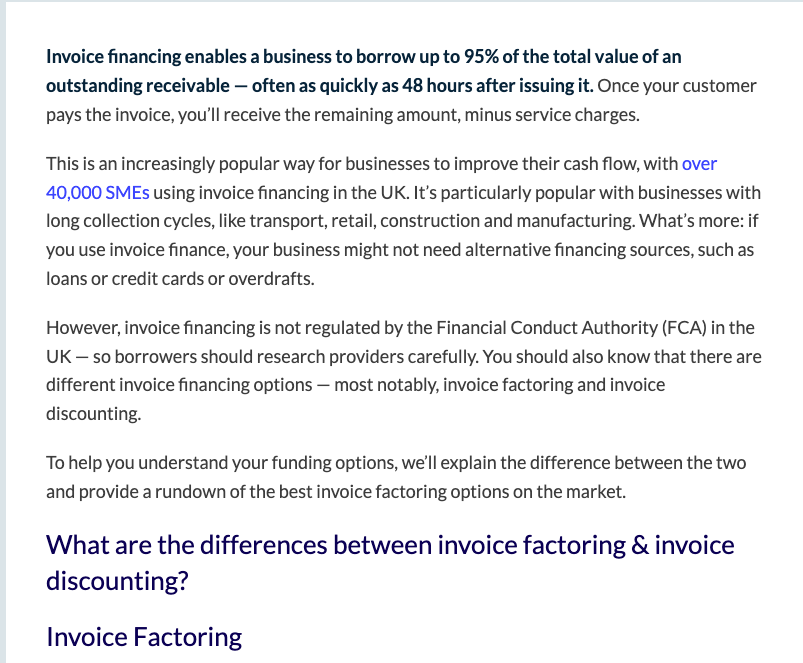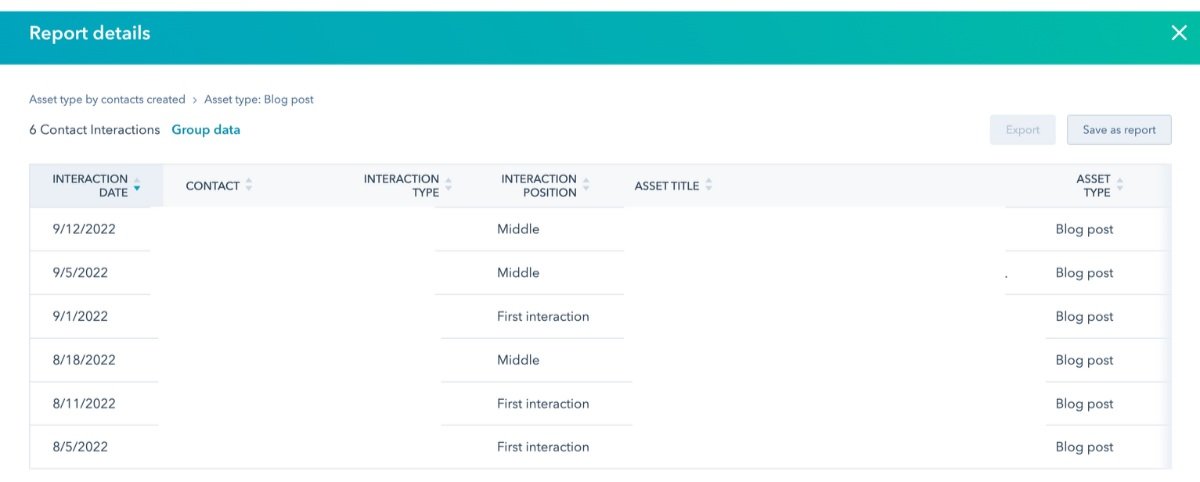If you’re doing research online about content marketing for financial services, you may be one of these situations:
- You work in marketing at a financial services company and want to invest more in content marketing as a marketing channel.
- You’ve already invested a lot in content marketing for your financial services company but aren’t happy with the results.
- You’re new to financial services and want to learn about how content marketing works in this industry.
When doing research for this topic online, you’ll likely have seen a lot of articles talk about “topic clusters”, creating fictional buyer personas and raising brand awareness.
Although there’s a time and place for that type of content, what we’ve too often seen is marketers investing a lot in this type of content without seeing the results they were hoping for.
An increase in traffic to your website may sound like progress, but it doesn’t always lead to an increase in revenue and customers. And this is the issue with many content strategies: very few will focus on what really matters, which is business value. Ultimately, you want to be able to create content that is tied to your business strategy.
In this guide, we want to show you how to create a financial services content marketing strategy that is aligned with business goals, specifically, customer acquisition.
We’ll go through:
- What’s unique about content marketing for financial services?
- The issue with how most financial services companies approach content marketing
- How to get started with content marketing for financial services that brings business results
- How we help financial services companies acquire customers with content
- The content strategy that enabled financial services payment company Zai to acquire $500k+ in opportunities with content
Note: at Mint Studios we focus on helping financial services companies acquire customers with their blog. Reach out to us to learn more about how we can help you.
What’s unique about content marketing for financial services?
It’s even more important that your content can be found online and is trustworthy
Whether you operate in the B2C or B2B world, selling financial services requires the buyer to trust you. A lot. Opening up a bank account is not the same as opening a Facebook or social media account. When it comes to money, people are more careful with the products they use.
Not just that, but finance is also a topic that people don’t understand well, and is also taboo. We aren't taught much about taxes, pensions or mortgages in school. We’re also usually uncomfortable talking about salaries, how much we save and our investment strategy with trusted people like family members.
When you have a topic that is not well understood and taboo to talk about, people need more guidance than with other topics. In 2024, people find that guidance in places like Google and social media. When they don’t know if their salary is high enough, they Google it. When someone talks about “index funds” and they don’t understand what that means, they might go to Youtube. When they don’t know which type of investment broker would be best for their needs, they might go to Reddit.
And this is also the case in the B2B marketing world. There are so many new regulations and laws every year, that buyers are constantly Googling what specific topics mean and comparing financial products.
All of this is to say two key unique things about content marketing in financial services:
- Your content needs to be present online, appearing when your target audience is doing research.
- Your content needs to help build trust, and therefore be trustworthy and authoritative.
Search Engine Optimization (SEO) – the activity of writing content that ranks for specific keyphrases on Google – needs to be part of your content marketing strategy. And the content you create needs to help with trust building. That means, don’t:
- Create content using AI without disclosing it in the content.
- Share information that is inaccurate.
- Create content which is regurgitated from somewhere else.
All of the above erode trust. When you’re creating content for financial services, it all comes down to trust.
In this article we’ll be mainly focusing on long form written content as Google is still the number one place people go to do research on financial services in 2024.
You’re competing against financial publications like Nerdwallet and Forbes
So maybe you’re thinking: perfect, I just need to put together an SEO team, start creating relatively good content – and that’s it! Google will help us rank!
That was the case back in 2012 - 2015, when not many companies were creating content online. Unfortunately in 2024, many more websites are competing on Google for real estate in organic search results.
Most notably, though, are the huge financial publications like Nerdwallet, Forbes and niche blogs like Money Under 30 or WalletHacks. These are content companies that have huge SEO teams and the sole goal of ranking on Google.
Which means it can be difficult as a financial services firm to rank for keyphrases like “best bank account” or “how to save money”.
But not all is lost: that doesn’t mean you shouldn’t create content for Google. It just means you have to be more strategic.
As we explain later down below, when putting together your content strategy, you’ll have to be strategic and careful about the keyphrases you want to target. And as you’ll see, you may be better off targeting phrases that are searched by fewer people, but indicate a much higher intent to buy. For example, targeting “best business credit card for travel agencies” rather than “best business credit card”.
All in all, content marketing for financial services is a competitive space. But that doesn’t mean there isn’t opportunity.
You have to spend many more resources on keeping your content compliant
Without the right compliance processes in place, you could end up in a situation where you’re struggling to get your content published.
That’s why compliance must be embedded into your content production process. We’ve written an entire guide on how to do this, but here are some quick tips:
- Make sure your compliance team is part of your content research process, where they can tell you which topics you can cover and which should be avoided.
- Have a recurring monthly meeting with your compliance team where you go over your content calendar and key topics, so you ensure everyone is aligned
- Keep a style guide with notes on words you can and cannot use.
- Make it as easy for compliance to review your content: use their formats, highlight areas where you may have questions, etc.
Most importantly, working with compliance is about building trust. If you’re always at odds with your compliance team, it’ll always be a challenge to get content published. But by building trust, you’ll be able to overcome that barrier.
Financial services marketers have to deal with challenges of creating content that adheres to compliance and don’t have the liberty to “just put it out there and see what happens”. Which means planning, tracking and understanding compliance is essential.
Read more: How to Navigate Compliance and Content Creation as a Financial Marketer
You’re likely under more pressure to deliver results
Financial services is one of the oldest industries in the world. This is very different to other industries like tech and Software as a Service, that are under 50 years old and mostly born online. For marketers working in tech industries, their leaders and bosses understand digital marketing a lot more since they were born on the internet.
But in financial services, as a marketer, you might not have that luxury. In other words, you’ll probably need to do a lot more educating on how content marketing works to your higher ups. In many situations, you’ll have to be able to make a business case for investing in content.
But content marketing can take years to work, especially if you start with creating content that focuses more on brand building.
As a financial marketer, it’s likely that you’ll have to put together a strategy that allows you to make a better business case for content marketing as soon as possible. In other words, you need to be able to get results sooner, so you can then create content that invests in the long term.
It may sound unfair, but it’s the reality of most financial services firms (unless you’re lucky!). You can either accept this and work with the industry, or spend hours fighting against it. The first way is a lot easier.
As we’ll see below, the typical content marketing strategy that starts with Top of the Funnel content marketing might be a great strategy – but the length of time it takes to see results means you’ll always be fighting against the tide. We go through a better alternative down below.
Your content must be authoritative
Whether you’re writing about capital markets, stock trading, payment processing or mortgages, the content must come from a place of authority. There are two main reasons for this:
- Trust: Remember what we said earlier – trust is incredibly important. In the health industry, we trust people who have a white coat and call themselves doctors. In financial services, we also listen to those who are an authority. Your content must come from someone who knows what they’re talking about.
- Google’s Updates: Financial services is seen as a Your Money or Your Life (YMYL) industry by Google, which means they put extra emphasis on authoritative companies. Along with the recent updates, Google favors content that comes from a place of authority.
But few people are great writers and also experts in financial services. Most people are either great writers, or experts in a specific topic. This can make it very hard to create authoritative content.
That’s why we advocate for the next best thing: asking writers to interview experts and create content based on those interviews – acting a bit like journalists.
Too many financial services firms hire writers who don’t know about financial services, and are therefore learning about the topic on the go and creating content based on research online. The issue with that is the content itself is a lot more beginner type content, and it can also cause delays in creating high quality content as experts need to constantly re-write and edit content.
Make sure your content comes from a place of authority, either by asking your experts to do some writing, or by asking your writers to interview experts.
Read more: Why You Should Create Content Based on Interviews With Experts
The issue with how most financial services companies approach content marketing
Considering the above, many financial marketers and agencies will take this approach to creating a financial content marketing strategy:
- Put together a list of keywords based on competitor websites.
- Prioritize the keywords that bring in a high volume of keywords.
- Create articles based on desk research that are designed to rank for these keywords.
- Distribute on social media.
- Buy backlinks.
So many marketers start their financial services content strategy by creating a huge amount of content that targets phrases like “invoice financing”, “how to save money” and “stock trading tips”. But as mentioned above, it’s a losing game. The Nerdwallets and Forbes of the world make it very hard to rank highly for these keyphrases. And in any case, your target audience won’t be using those phrases. You’ll get a lot of traffic, but not many customers.
This is how you end up in a situation where you’re investing a lot into content, without the results you were hoping for.
If you’re an embedded finance company, your potential customers are not looking for “types of payment methods” or “what is a direct debit”. They are likely looking to solve a problem. They are trying to understand how they can use payments to improve their business model. They are looking for ways to spend less time on reconciliation. They are trying to increase the speed of payments. These are your answers you want your content to focus on.
That’s why, instead of a keyword or topic first approach, we believe it makes more sense to flip the typical approach on its head.
Instead of searching for high volume keywords to rank for, start by doing customer research and spending time understanding what your ideal customer is searching for online. When someone is close to converting, what are their pain points? Who do they compare you to? What questions are they asking?
Start by targeting people who are already looking for a solution to their problem (the Bottom of the marketing Funnel (BOFU)), and only once you’ve done a good job targeting them and have some results, you can move your way up.

It’s a completely different process, but as we’ve mentioned above, as a financial marketer you are under more pressure to demonstrate results than someone who is working in a more tech-savvy industry. That’s why you want to implement a strategy that helps you get results sooner, so you can then make a business case and invest in the long term.
We set up our agency because too many financial services brands and financial institutions were investing in content, and not seeing the results they were hoping for. This led to marketing budgets being slashed, and even some marketers losing their jobs.
Here’s how we approach content strategy instead:
How to get started with content marketing for financial services that brings business results
So what’s a better approach? The strategy of targeting hundreds of high volume keywords that are only slightly related to what you do doesn’t work in 2024.
In 2024 and beyond, you need a content strategy that is more aligned with business results, and actually speaks to your target market.
The approach we take has helped financial services companies like Zai, Jeeves and Parpera acquire $1M+ of customers with content marketing.
1. Create a content strategy that starts by targeting the bottom of the funnel
The best way to explain BOFU is to go through an example. Think of the person that types in “invoice financing” into Google. It could be an undergraduate writing a paper about the invoice financing industry. It could be an accountant who’s trying to understand how they can help their clients. It could be a candidate who applied for a position at an invoice financing company.
But this might not be true with someone who’s looking up “top invoice finance providers”. Someone typing this up into Google is a lot more likely to be someone who’s looking to start using an invoice financing solution (note the “more likely” – sure, undergraduates may still be looking this up, but it’s more likely to be a business). Sure, maybe only 50 people search for “top invoice finance providers” on Google versus 1,000 people who search for “invoice financing” – but who would you rather be talking to? People who are close to buying? Or people who may never be interested in your solution?
This is why we advocate starting with the Bottom of the Funnel. That means: targeting people who know they have a problem and are already looking for a solution. Once you’ve targeted those people, you can then create more high-level content that educates a broader group of people.
So how do you figure out what your ideal customer is looking for? The best way is to ask them directly, via customer interview and surveys. The second best way is to ask your salespeople (or anyone who is very customer facing).
When we start working with a client, we spend 3 - 4 weeks interviewing salespeople and customer success teams to understand their ideal customers’ pain points, top use cases and how the product matches those pain points. We ask questions like:
- What was the last prospect/company that you had a really easy time closing? What type of prospects are the ones that are the easiest to close?
- What are you usually compared to? What are the alternatives?
- What is the most common reason for buying your product?
- How do they currently solve X and how much does it cost to do so?
- What happened last time their problem came up? What did they do?
You can read more about how to do that here: How to Do Research for Bottom of the Funnel Content Marketing.
Based on that research, you’ll be able to come up with content ideas and keywords to target your best customers. Some examples might be:
- Payment provider for law firms
- Stripe alternatives
- Business insurance for sole traders
- Alternatives to articles (e.g. alternative to Paypal)
- Comparison articles (e.g. Xero vs Freeagent)
- Best of articles (e.g. best accounting software for freelancers)
- Pricing pages (e.g. how many fees do [incumbent competitor] charge?)
- Use case blogs (e.g. how do I open a bank account as a contractor?)
Once you’ve done this type of research, you’ll be more prepared to start creating content on these topics.
Make sure your strategy starts with targeting those who are close to converting. You can see below how this strategy allowed Zai to attribute hundreds of thousands of dollars to the content we were creating.
2. Create content that is written for the right level of knowledge of your target buyer
You might start your article targeting “invoice financing” by first defining what invoice financing means. But you shouldn’t do that for your article targeting “top invoice financing providers”. Someone who is comparing invoice financing solutions clearly already knows what invoice financing is and is ready to buy.
The point is: your content needs to be written for the right audience. If you’re doing BOFU content, make sure you’re writing for the buyer, and not just anyone interested in the topic.
Which means that the type of information you include is also different. With BOFU content, you’re instead going deep on pain points, use cases, examples and product features and benefits. You’re giving the reader the information they are looking for, and helping them make a decision. Not just educating them.
You can see the difference in how the two pieces below are written. Although they are both ranking for the keyphrase “best invoice finance providers”, one is clearly written by someone who knows their target market, while the other isn’t. If you want results from your quality content, you need to write for the right audience.


3. Create content based on interviews with internal experts
A lot of website content is written by someone who is rehashing and regurgitating content that is already published. But this just leads to copycat content that doesn’t stand out. It also doesn’t lead to content that is trustworthy and authoritative.
As mentioned earlier, with recent Google updates and the uniqueness of the financial services industry, trustworthiness and authority are incredibly important.
You could ask your internal experts to create content, but they are usually the busiest people on the team and will struggle to commit the time.
So the next best option is: instead, ask your writers to create content based on interviews with your team. We do this with all our clients because creating content based on interviews allows us to:
- Create relevant content that is actually the voice of the company, which in turn helps position your company as a thought leader.
- Add unique insights into the content that can’t be found elsewhere.
- Go a lot deeper on the product and therefore talk about product features and benefits in the article.
- Avoid regurgitated me-too content. When the writer can base their content on interviews, you don’t end up with regurgitated content and the content is much more high-quality.
If your experts are not going to write content, then make sure your writers are creating content based on interviews with them. It’s the best way to create authoritative content that helps meet your goals. Again, here are two pieces of content, one is based on an interview with an expert and one isn’t. You can really clearly see the differences:
- How to manage company spending for remote teams [Spendesk]
- Spend Management For Remote Employees: Try Jeeves [Jeeves]
We go into detail about these two separate articles here: How to Write About Your Product In Your Content [And Increase Conversions]
4. Track sales related metrics with your content
As mentioned above, one of the unique challenges in financial services marketing is that you have more pressure to deliver results and make a business case for content marketing.
In order to make a business case, you need to be tracking the right metrics. In other words, the right business metrics. Traffic, backlinks and Domain Authority are all metrics that leaders at financial services companies don’t care about. Instead, you need to report with metrics of revenue, leads and ROI.
The great thing is that tools like Hubspot, Google Analytics allow you to track a lot of these metrics. But to do it correctly you need to set up correctly.
By setting up Hubspot correctly with our client, Zai, we were able to attribute hundreds of thousands of dollars to our content. We used first click, last click and influenced attribution to see how our content influenced a customer or deal.

Not only did this allow marketers on the Zai team to make a business case for content, but it also helped direct their overall marketing strategy. We now knew which articles were bringing in the most revenue, which meant that they knew which content topics they needed to focus on to help support growth.
Get your marketing analytics set up correctly and make sure you’re tracking sales related metrics, as this will make your life a lot easier when reporting to the higher ups.
If you’re using Hubspot, here are some reports you can set up to make sure you’re tracking everything correctly: How to Track the Quality of the Leads Your Content Brings in [With 4 Hubspot Reports]
How we help financial services companies acquire customers with content
This methodology above has allowed us to help financial services firms acquire customers worth $1M+ with content.
At Mint Studios, we’re specialists in:
- Creating high quality, expert-based financial content
- Creating financial content that brings in customers
Here’s what you get when you work with us:
You get customers and revenue, not just content
As far as we know, we’re the only content marketing agency that specializes in customer acquisition for financial services companies with content. Most agencies will either focus on thought leadership content, or use paid media like LinkedIn and Google Ads to bring in leads. We’re accountable for leads, customers and revenue via content specifically.
That means we’re a lot more aligned with your objectives. It also means you can finally report on business results to your higher ups and make a business case for content.
If you’ve read the sections above, then you know how we do it: we take the time to understand your customer pain points, then we create Bottom of the Funnel content that targets people who are doing research on Google and are closer to converting. We then set up all the reporting in your Hubspot so you can see the results over time.
You work with people who know financial services well
You won’t have to deal with writers who are learning on the job. Everyone on our team has experience writing about financial services and is trained to write BOFU and high quality content.
We also already have all the processes in place to learn about your product quickly. We have experience dealing with compliance, and we have in-depth knowledge on topics like embedded finance, invoice financing, payments, private equity and capital markets.
You can set and forget the process
Once we have all the content processes up and running, you won’t need to be involved in the day to day. We take care of everything including the strategy, interviewing experts, writing, editing, publishing on your CMS and reporting on results. After the first few months, you’ll be able to see how your content grows and results grow without having to spend hours editing, rewriting and educating writers.
We act as an extension of your digital marketing team and we use tools like Slack and Teams to communicate on a daily basis. It makes it a lot easier for teams with limited resources to get up to scratch with content.
The content strategy that enabled financial services payment company Zai to acquire $500k+ in opportunities with content
Zai is a payment orchestration company based in Australia, that was looking for a content partner that would help them acquire more customers with content..
When we started working with them, we put in motion our bottom of the funnel content strategy, where the plan was to target technology and product managers who understood their payment problem and were actively looking for it.
There are two parts to our work:
- The strategy
- The content itself
Strategy: After interviewing members of their sales and product team, we had a good understanding of their target market’s pain points. So we started by targeting keyphrases that had very low traffic but indicated high buying intent, which was fine, because our objective was customer acquisition.
Some examples of keyphrases were:
- “Top direct debit solutions”
- “BPAY API”
- “Split payments API”
Content: The writing itself required knowledge about payment APIs and the ability to write more technical content. Every piece of content was based on an interview with an internal expert at Zai and our writer had a background in fintech, allowing us to go deep on the product and creating unique content that couldn’t be found anywhere else.
Examples of the content we wrote include:
- Direct Debit API: How to set one up (and when to use one)
- 3DS2: Everything you need to know and how to prepare for it
- Multi-party payments: How they work and when to implement them
Because we were using Hubspot, we could track first and last click attribution: those who discovered Zai via a blog post that was ranking for a specific keyword, as well as those who discovered Zai elsewhere and then converted on the blog post.
Here’s the screenshot of the dashboard at a certain period of time:

Thanks to our setup, not only could we track which new contacts came in via each blog post, but their Hubspot was also linked to their Salesforce. This meant we could also see the revenue and quality of the deals that the blog posts were bringing in:

Here’s another screenshot (the values below are examples and are not indicative of Zai’s actual deal amount):

After over a year of working together, we were bringing enough deals every month that we were able to cover the cost of our services, plus a lot more. The result was an incredible working relationship where we were incredibly aligned on business results, while still creating great content.
Andrea Linehan, ex-CMO at Zai, summarized our work together with:
“The Mint solution is specialized, out-come driven and transparent. The team are experts in what they do and are a joy to work with.”
You can read more details about our work with Zai here: Case Study: How We Helped Zai Gain Multiple SQLs Per Month with Content
Content marketing for financial services: start with bottom of the funnel content to get results
If you’re looking to do financial services content marketing that focuses on customer acquisition, then you’re better off starting by targeting those who are already close to converting.
That way, you get results sooner, and are able to make a better business case to your leaders for investing in content. It also means you can avoid competing with the large publications. After that, it makes sense to work your way up the funnel and create more educational type content.
If this is something you’re interested in pursuing or learning more about, reach out to us below.











